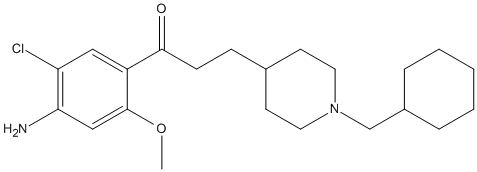Donecopride
Multitarget-directed ligand (derivative of Donepezil and RS67333. 5-HT4R partial agonist (Ki = 10.4 nM) and AChEI (IC50 = 16 nM)
General
Type : Multitarget,5-HT-receptor-ligand,Derivative of Donepezil,Piperidine
Chemical_Nomenclature : 1-(4-amino-5-chloro-2-methoxyphenyl)-3-[1-(cyclohexylmethyl)piperidin-4-yl]propan-1-one
Canonical SMILES : COC1=CC(=C(C=C1C(=O)CCC2CCN(CC2)CC3CCCCC3)Cl)N
InChI : InChI=1S\/C22H33ClN2O2\/c1-27-22-14-20(24)19(23)13-18(22)21(26)8-7-16-9-11-25(12-10-16)15-17-5-3-2-4-6-17\/h13-14,16-17H,2-12,15,24H2,1H3
InChIKey : FTRZTHFGTILUPE-UHFFFAOYSA-N
Other name(s) : CHEMBL3417009,SCHEMBL17709631,BDBM50079362,J3.528.494J,MR31147
MW : 392.96
Formula : C22H33ClN2O2
CAS_number :
PubChem : 86582973
UniChem : FTRZTHFGTILUPE-UHFFFAOYSA-N
IUPHAR :
Wikipedia :

Target
References (4)
| Title : Donecopride, a Swiss army knife with potential against Alzheimer's disease - Rochais_2020_Br.J.Pharmacol_177_1988 |
| Author(s) : Rochais C , Lecoutey C , Hamidouche K , Giannoni P , Gaven F , Cem E , Mignani S , Baranger K , Freret T , Bockaert J , Rivera S , Boulouard M , Dallemagne P , Claeysen S |
| Ref : British Journal of Pharmacology , 177 :1988 , 2020 |
| Abstract : Rochais_2020_Br.J.Pharmacol_177_1988 |
| ESTHER : Rochais_2020_Br.J.Pharmacol_177_1988 |
| PubMedSearch : Rochais_2020_Br.J.Pharmacol_177_1988 |
| PubMedID: 31881553 |
| Title : Novel multitarget-directed ligands targeting acetylcholinesterase and sigma1 receptors as lead compounds for treatment of Alzheimer's disease: Synthesis, evaluation, and structural characterization of their complexes with acetylcholinesterase - Lalut_2019_Eur.J.Med.Chem_162_234 |
| Author(s) : Lalut J , Santoni G , Karila D , Lecoutey C , Davis A , Nachon F , Silman I , Sussman JL , Weik M , Maurice T , Dallemagne P , Rochais C |
| Ref : Eur Journal of Medicinal Chemistry , 162 :234 , 2019 |
| Abstract : Lalut_2019_Eur.J.Med.Chem_162_234 |
| ESTHER : Lalut_2019_Eur.J.Med.Chem_162_234 |
| PubMedSearch : Lalut_2019_Eur.J.Med.Chem_162_234 |
| PubMedID: 30447434 |
| Gene_locus related to this paper: torca-ACHE |
| Title : Novel multitarget-directed ligands (MTDLs) with acetylcholinesterase (AChE) inhibitory and serotonergic subtype 4 receptor (5-HT4R) agonist activities as potential agents against Alzheimer's disease: the design of donecopride - Rochais_2015_J.Med.Chem_58_3172 |
| Author(s) : Rochais C , Lecoutey C , Gaven F , Giannoni P , Hamidouche K , Hedou D , Dubost E , Genest D , Yahiaoui S , Freret T , Bouet V , Dauphin F , Sopkova de Oliveira Santos J , Ballandonne C , Corvaisier S , Malzert-Freon A , Legay R , Boulouard M , Claeysen S , Dallemagne P |
| Ref : Journal of Medicinal Chemistry , 58 :3172 , 2015 |
| Abstract : Rochais_2015_J.Med.Chem_58_3172 |
| ESTHER : Rochais_2015_J.Med.Chem_58_3172 |
| PubMedSearch : Rochais_2015_J.Med.Chem_58_3172 |
| PubMedID: 25793650 |
| Title : Design of donecopride, a dual serotonin subtype 4 receptor agonist\/acetylcholinesterase inhibitor with potential interest for Alzheimer's disease treatment - Lecoutey_2014_Proc.Natl.Acad.Sci.U.S.A_111_E3825 |
| Author(s) : Lecoutey C , Hedou D , Freret T , Giannoni P , Gaven F , Since M , Bouet V , Ballandonne C , Corvaisier S , Malzert Freon A , Mignani S , Cresteil T , Boulouard M , Claeysen S , Rochais C , Dallemagne P |
| Ref : Proc Natl Acad Sci U S A , 111 :E3825 , 2014 |
| Abstract : Lecoutey_2014_Proc.Natl.Acad.Sci.U.S.A_111_E3825 |
| ESTHER : Lecoutey_2014_Proc.Natl.Acad.Sci.U.S.A_111_E3825 |
| PubMedSearch : Lecoutey_2014_Proc.Natl.Acad.Sci.U.S.A_111_E3825 |
| PubMedID: 25157130 |